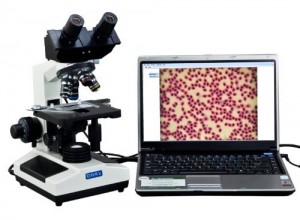Update #14 – Buying A 3D Printer and Laboratory Supplies – May 1st, 2014
In the last month I have thought about how we can push the endeavor further along and I thought that we need to start to move away from the theory and look into doing some lab work. So I have started to buy some laboratory equipment to try to regrow cartilage-like tissue of my own.
Here are the following Items I am planning on buying over the next 6 months.
 OMAX 40X-2000X Digital Compound Microscope – The model will have a built-in 3.0 USB Camera which will allow me to take pictures. The model has 100 slides so that is kind of nice that at least in the beginning I don’t need to buy the slides.
OMAX 40X-2000X Digital Compound Microscope – The model will have a built-in 3.0 USB Camera which will allow me to take pictures. The model has 100 slides so that is kind of nice that at least in the beginning I don’t need to buy the slides.
I am planning on getting pig leg from the local market with intact cartilage so that I can do a clean slice of the articular cartilage to find the chondrocytes. If I can isolate a large enough culture of chondrocytes, I want to test certain types of growth factors I’ve bought on them to see how well they can proliferate.
Lab Scalpel – This is to slice biological tissue into thin flat for observation. I might need to get some type of blue or purple staining solution so that certain organelles or cells can be more easily visible.
Lab Culture Petri Dishes – This is to grow cultures. I have worked in a microbiology lab before testing anti-microbial compounds and BSL-3 type bacteria (Staph and Strep mostly) so it should not be that hard to figure out how to grow an agar plate.
Lab Centrifuge – We will need to at some point centrifuge the ECM from the cells for filtration. This is to get as much of the chondrocytes out as possible, and into a type of growth medium like calf serum to let them grow successfully without turning to bone cells.
3D Printer – I recently attended a convention for computer enthusiasts and found out that I can buy my own personal 3D Printer Kit. (The website is PrinterBot.com). I am having a hard time deciding whether I want to get the preassembled model or the unassembled model so that I can really learn about how the machines work. I am leaning towards the Black Preassembled Model currently, which is listed at $600 which would include the plastic mold wires.
3d printers require that you have a .stl file but that is easily doable if one considers that Google SketchUp has that extension. I’ve used Solidworks before (and a little bit of Autocad) but I don’t want to pay the thousands to use those software. If you guys remember, I had drawn a picture of a proposed LSJL Machine years ago using Google SketchUp.
Arduino (UNO model) – This is just for testing. I don’t have any experience in programming boards before but I have used Python, and Matlab before.
Raspberry Pi – I recently started to look back into robotics (I used to be part of a Robotics Club back in school) and how to use either the Arduino platform or the Raspberry Pi to act as a brain to execute programs. I think Raspberry Pi requires C which I have not used before. The Raspberry Pi will need to be eventually used to program say the electrospinning machine.
Electrospinning Machine – The researcher Warren Grayson from John’s Hopkins was kind enough to send a paper which showed how he was able to successfully grow a synthetic growth plate model using the device. (Refer to study “Engineering anatomically shaped vascularized bone grafts with hASCs and 3D-printed PCL scaffolds“). This one is going to be VERY expensive, at around $10,000-$20,000 usually. This device is something I won’t be buying for at least a few years.
BMP2 Recombinant Human Protein – sold by the website Life Technologies – This one is going to be expensive, at around $1,100 for just 100 micrograms. I am not sure how I can afford this one, since I would need to use it quite extensively.
I wanted to remind the readers that trying to do any type of research in the biological sciences requires extensive initial capital to get started. I am guessing it would take about $30,000 to get started.
All these claims that I am making, about what I want to buy to get a real biology lab started is a little over the top but those are my plans going forwards through the next few years. It is going to be a very slow process going through this year, accumulating all the parts that I need.
I want to get the lab work started, to test to see how a local sub-periosteal injection of a growth factor well known to have chondrocyte inducing properties would test when we put it in the articular cartilage layer. If the BMP-2 or OP-1/BMP-7 has a high level of chondrocyte induction, I want to recreate the lab results of Grayson and Ballock, using the scaffold, chondrocyte, and growth factor method.

I dont get it, that 3D printer just make plastic models, you cant make a growth plate with that!